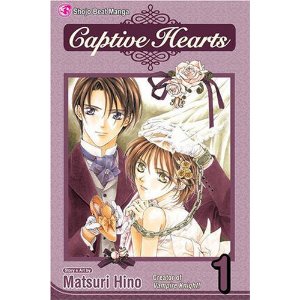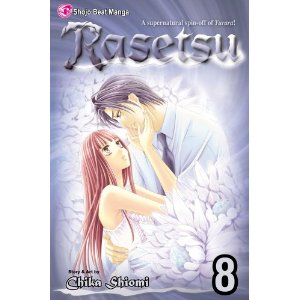One nice thing about the insanely cheap prices for first volumes in the Viz Media iPad store last month is having the opportunity to try out some new titles that I wouldn’t ordinarily read. Sometimes this will make for a pleasant discovery, and other times I will just confirm that certain manga titles aren’t for me.
Rosario Vampire Volume 1 by Akihisa Ikeda
Rosario Vampire is a fairly standard harem manga that provides the slight twist of a monster school setting. Tsukune is an average human boy who finds himself inexplicably attending a high school for monsters where they practice their skills in pretending to be human. Tsukune is promptly befriended by the most beautiful and powerful girl in the school, a vampire named Moka. She’s drawn to him as a blood source, but she also acts as his only friend. The story in Rosario Vampire is pretty much what you’d expect. There’s plenty of accidental touching and viewing of young monster babes in their underwear. Tsukune’s status as an undercover human is occasionally threatened, and Moka is able to unleash her mystical powers to defend Tsukune whenever he needs rescuing. The art is clear and easy to follow, and for a shonen harem manga this series does seem competently done. But there wasn’t anything extra to engage me, as a reader who isn’t really in the shonen harem manga target demographic. If I want to read a manga about a schlubby human boy tormented by a oblivious girlfriend with amazing powers, I’d just go back and track down some Urusei Yatsura.
Nura: Rise of the Yokai Clan Volume 1 by Hiroshi Shiibashi
I’ve written before about having “yokai fatigue”. There are so many manga series that feature people fighting spirits, it really takes a special series like Kekkaishi to win me over as a dedicated reader. Nura: Rise of the Yokai Clan does exhibit some cliched shonen plot devices, but the basic premise provides an interesting counterpoint to the standard super-powered teen fighting evil spirits plot that manga readers have come to expect. In Nura, the hapless teen with hidden powers isn’t an ordinary human. Rikuo’s been born as the heir to the Yokai Clan – a group of powerful spirits that functions a little bit like a powerful mafia family. Nura’s grandfather the supreme commander is powerful, but he tends to use his mystical powers to perform a dine and dash when he takes his grandson out to eat at local restaurants. Rikuo grows up in two worlds, surrounded by strange spirit guardians who present themselves as heroic and his classmates at school who think that yokai are evil and annoying. Rikuo doesn’t want to become a yokai, but his monstrous side comes out when his classmates are threatened.
Nura: Rise of the Yokai Clan starts out with the familiar framing device of showing Rikuo as a small child in the first chapter, while the second shows him as an adolescent still struggling with the demands of his family and normal school life. One of the things I look forward to in yokai manga are the monster character designs, and Shiibashi comes up with some whimsical supporting characters. I was fond of the spiral-eyed Yuki-Onna, and the neckless Kubinashi, whose head floats above his torso. The first volume of Nura: Rise of the Yokai Clan just seems to be setting up many of the story elements. Rikuo is unaware of his stronger Yokai side. His classmates are fascinated with ghost busting. A powerful girl exorcist transfers into Rikuo’s class. These events are pretty familiar to anyone who has read a lot of Yokai manga, but the positioning of the Nura clan as a powerful Yokai family and their interactions with Yokai from other clans was much more interesting. These elements reminded me a bit of The Godfather, if the mafia families in question were all ancient Japanese spirits. Nura: Rise of the Yokai Clan does seem like a promising shonen series and I’m going to read the next volume to see if the more interesting aspects of the first volume continue to be developed.



